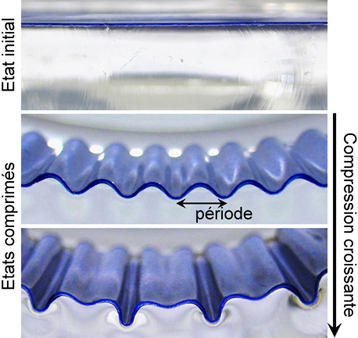Take a thin sheet of a solid material and try to compress it in such a way that it remains flat. You won't succeed, since the sheet bends systematically along its entire length. This is known as buckling. Now stick the same sheet onto a soft, thick substrate and compress it again in the same way: this time, it forms an extremely regular pattern of small wrinkles characterized by a particular distance between them, called the period.
You can see these regular folds by compressing the skin on the top of your hand between thumb and forefinger, or by letting a piece of fruit dry up.

Crédit : Fabian Brau
If at this stage you continue to compress the sheet, a totally new and unexpected phenomenon occurs. The folds formed divide into two families: in one of them the amplitude increases, while in the other it diminishes. One fold in two concentrates all the deformation energy, creating a structure with a period which is double that of the initial period. If you further increase compression, the same process starts over again, leading to a fourfold increase in the initial period, and so on.
In a new approach, a group of researchers have shown that the same mechanism governs the emergence of such doubling of the period both in folded structures and in the to-and-fro motion of oscillating systems such as a pendulum with varying length (like the enormous incense burner in the cathedral of Santiago de Compostela, the Botafumeiro), or a swing. There is thus a similarity between the equations that describe oscillations in space (as in folded structures) and oscillations in time (as in variable length pendulums).
This example forms part of a wider context: the researchers seek to explain the morphogenesis induced by mechanical instability. This phenomenon often occurs in nature, such as when folding of geological strata gives rise to mountains, or when living tissue is formed of two layers growing at different rates (as in the brain, skin and intestines). The approach used here by the scientists reveals underlying connections between seemingly unrelated phenomena. The new theoretical model developed by the researchers will make it easier to understand and therefore predict the emergence of such folded structures. This work could also have repercussions in technological fields, since it opens the way to the development of new micro manufacturing methods to model matter by creating regular micrometer-scale structures.
Citation: Fabian Brau, Hugues Vandeparre, Abbas Sabbah, Christophe Poulard, Arezki Boudaoud and Pascal Damman, 'Multiple-length-scale elastic instability mimics parametric resonance of nonlinear oscillators', Nature Physics, October 31 2010





Comments